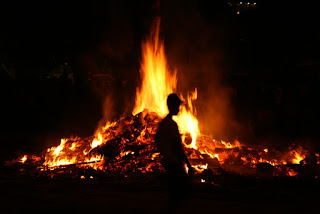Ideas to star writing
What
to do?
With a partner share a dramatic moment that
contains an emotional trigger. As you listen to your partner’s story, keep in
mind that you will be writing this story. You can fictionalize this story or keep
to the exact details as they are relayed to you. You can also write in any
genre you choose.
An
example
Out
of respect for the privacy of my partner’s story, I won’t relay the details she
told me, but I will say that it was about an incident that brought a lot of
grief into the family.
Dad sat me and my brothers around a pile of
sticks and wood he had gathered from the outskirts of the house around our
farm. The sun was setting and light flickered off his face, highlighting the
sweat that dripped onto the wood like a leaking tap. On the horizon a wallaby
stood watch, like a leader in an aboriginal ceremony.
‘Stay here,’ my father spat at us. ‘Missy,
you look after your brothers now. I’ll be back.’ He seemed to glide back toward
the house, which was behind us.
As soon as he left my brothers became
restless and stood up looking for something to do. I knew that their movement
away from the pile would unsettle the careful plan my father had concocted as a
way of relieving the sorrow that had descended on the house.
I took out two lollipops my mother had
given me as a prize for cleaning the dishes seven days in a row and resentfully
handed them over to my brothers.
‘You must stay here,’ I demanded. ‘Sit’.
Content with their sweets, they sat and
began their feast. That should keep them busy for a while, I thought, looking
over my shoulder, wondering when my father was coming back.
I could see my father returning with a
wheelbarrow overflowing. It was only as he came closer that I could make out
the contents. It became clear to me what this special bonfire was really about.
I could see the remnants of my baby brother’s possessions¾nappies, hand-me-down toys and Bonds playsuits. My father picked up
each item and carefully placed them in between the bits of sticks and wood so
that eventually the colourful pieces dotted the pile like a chocolate cookie
with smarties. He removed an old newspaper from under his arm and scrunched up
pieces of paper and inserted them underneath.
I became transfixed by a rubber doll that
sat on top of the pile and I wondered how it got there. It was my favourite toy
as a child. It had been mixed up with my brother’s toys and now its rubbery
skin was about to melt in the funeral fire. I was horrified and felt to stand
up to recue it, but the intensity of my father’s face, who was now standing
with a fiery piece of newspaper, stopped me in my tracks. We watched the pile
catch fire in one ferocious blast. The flames flickered in and out of each
other, growing towards the sky as if competing to be the first to reach the
clouds. Still I could see the creamy body of my doll morphing into half cooked biscuit
batter. Still I could see the doll’s black eyes staring up into the heart of
the flames, as the wallaby kept a restful vigil.
https://www.flickr.com/photos/elentir/3663267501
